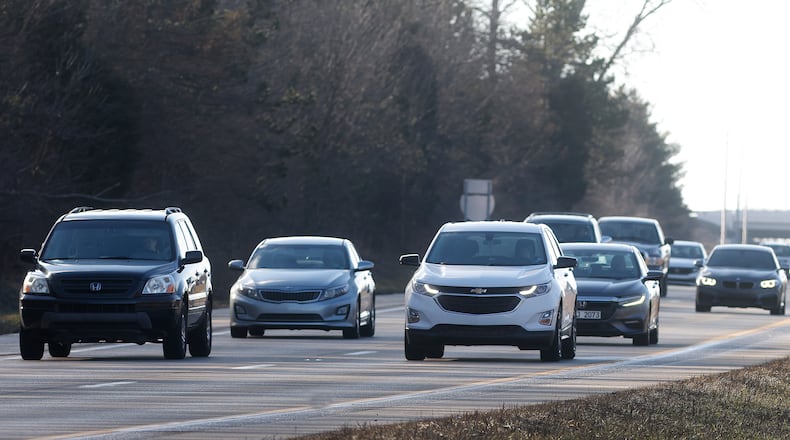Auto insurance companies have been raising rates in the double digits in recent years, Scroggins said, such as from 15% to 25%. The prices are expected to jump 7% this year on average in the U.S. after going up 20% the previous year.
“I saw 50% in one market two years ago,” Scroggins said. Even with these increases, carriers are still having trouble making money given riskier driving behaviors, more crashes, more traffic violations, more litigation over insurance claims and rising repair costs.
“That’s how fast the claims activity had skyrocketed,” Scroggins said.
Costs vary by state, company, driving habits
Rates vary depending on a number of factors, including location as Ohioans may see just a 5% rate increase or even some decreases, said Scroggins.
The national average cost of full insurance is expected to reach a high of $2,101 a year, or $175 a month, but Ohio’s average cost for car insurance is expected to be $115 a month, according to ValuePenguin.com, a LendingTree company. This is 35% less than the national average.
While Ohio is the seventh largest state in the country, its rates are among the lowest in the country, said Jeff Smith, CEO of the Ohio Insurance Agents Association, a trade organization for independent insurance agents.
“While everyone is feeling the squeeze from higher auto insurance premiums, be very grateful that you’re in the state of Ohio,” Smith said.
Four states are estimated to have lower monthly costs than Ohio, including Idaho at $111 a month, Vermont at $107, New Hampshire at $107 and Maine at $103, according to the State of Auto Insurance in 2025 report published by ValuePenguin.
Coverage in the most expensive states include Nevada at $286 per month, Florida at $272 and Michigan at $263, according to ValuePenguin.
The biggest rate hikes are expected from American Family, at 16%; All State, at 11.2%; and Liberty Mutual, at 10.2%. Nationwide and Farmers Insurance are expected to increase by 9.7% and 9.6%, respectively.
On the lower end, USAA drivers can expect an average of 2.6% increase over the next year, ValuePenguin said. Geico and Progressive are raising rates only a small amount in 2025.
Factors driving these increases
The cars themselves are part of the reason insurance premiums have risen in recent years and are expected to rise again this year.
“The cars are more expensive to fix,” Smith said. Newer cars have more advanced technology included in them, increasing the cost of the parts for car repairs.
Without taking labor into account, auto part replacement costs are expected to rise by 2.8% in 2025 compared to 2024, according to the Insurance Information Institute, a nonprofit research group. With labor, that cost increase is estimated to be 3.8%.
Car insurance increases also follow the rising costs of goods and services.
“Insurance premiums are typically the last thing to follow a high inflationary period,” Smith said.
Tariffs being implemented by the White House could also have an impact on rates as about 60% of replacement car parts are imported from other countries, according to ValuePenguin. Higher parts costs mean higher repair prices, which would likely result in higher premiums.
If tariffs have an effect, it likely wouldn’t be seen soon, said Scroggins. Establishing rates is a two to three year cycle.
“It’s very unlikely that those would have an immediate impact on rate levels,” Scroggins said.
Uninsured, risky drivers impact rates
In 2020, the industry provided $14 million in rebates and discounts to policyholders in anticipation of lower losses related to reduced miles driven during the COVID-19 pandemic lockdown, according to the Insurance Information Institute.
After the number of drivers on the road returned to pre-pandemic numbers, those discounts quickly deteriorated as a result of riskier driving behavior, the research group said. There have been more fatalities and injuries, leading to increased attorney involvement in claims and more repair costs.
An estimated 20% of drivers also don’t have car insurance, which raises coverage costs for everyone, Smith said.
“As an insured driver, you have to purchase uninsured motorist coverage to make sure that you’re covered against the 20% of the drivers who don’t have any coverage,” Smith said.
For drivers concerned about their coverage costs, Smith says they should work with their insurance agents to see what all of their options are.
“Independent insurance agents have multiple carrier options,” Smith said.
For people who are good drivers, they could consider utilizing insurance telematics, which is where some auto insurers install a GPS-tracking device to monitor driving habits. There are also usage-based insurance options.
“If you’re a safe driver, that’s good. If you’re not such a safe driver, then that might work to your detriment,” Smith said.
Drivers with a traffic violation or accident could see an average car insurance rate increase of 53% in 2025, according to ValuePenguin.
Drivers overall may get a bit of break this year, though, with lower increases in the market.
“After a couple years of high activity, I think insurance shoppers are going to have a little bit of a respite from the rate activity,” Scroggins said.
About the Author



